林书豪英语演讲ppt
- 格式:ppt
- 大小:2.41 MB
- 文档页数:10
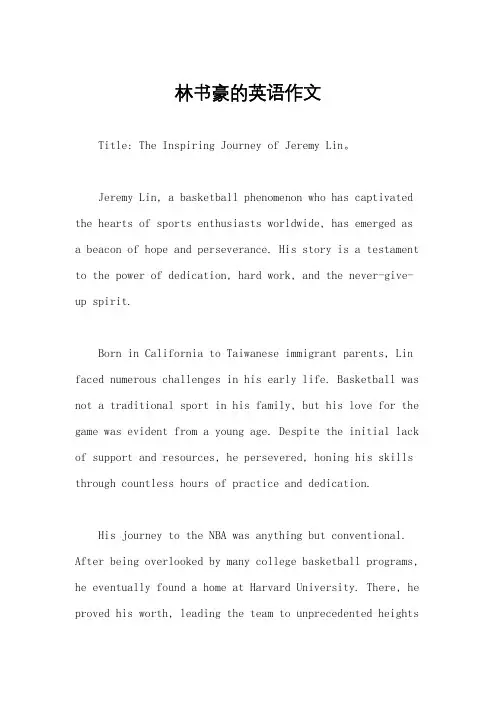
林书豪的英语作文Title: The Inspiring Journey of Jeremy Lin。
Jeremy Lin, a basketball phenomenon who has captivated the hearts of sports enthusiasts worldwide, has emerged as a beacon of hope and perseverance. His story is a testament to the power of dedication, hard work, and the never-give-up spirit.Born in California to Taiwanese immigrant parents, Lin faced numerous challenges in his early life. Basketball was not a traditional sport in his family, but his love for the game was evident from a young age. Despite the initial lack of support and resources, he persevered, honing his skills through countless hours of practice and dedication.His journey to the NBA was anything but conventional. After being overlooked by many college basketball programs, he eventually found a home at Harvard University. There, he proved his worth, leading the team to unprecedented heightsand earning numerous accolades. However, the road to the NBA remained uncertain. Despite his stellar college career, Lin faced skepticism and doubts about his ability to translate his game to the next level.But Lin was not deterred. He persevered, using his determination and hard work to overcome adversity. In 2010, he signed with the Golden State Warriors as an undraftedfree agent. However, his journey was not without challenges. He was often relegated to the bench, facing limited playing time and opportunities. But Lin never gave up, continuingto work hard and improve his game.His breakthrough moment finally came in 2012。

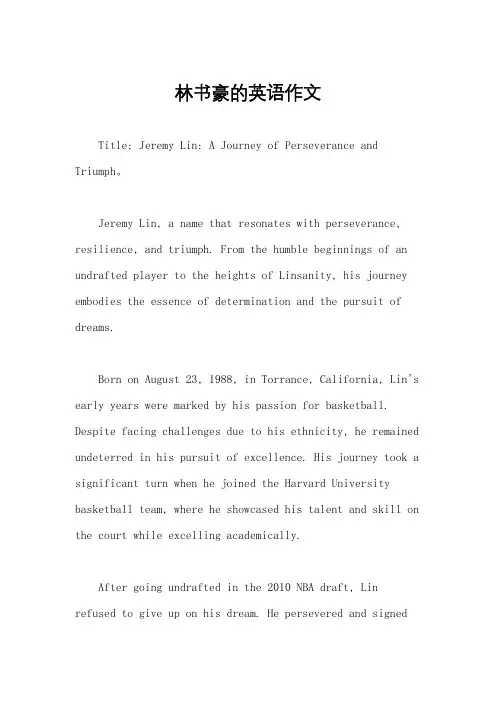
林书豪的英语作文Title: Jeremy Lin: A Journey of Perseverance and Triumph。
Jeremy Lin, a name that resonates with perseverance, resilience, and triumph. From the humble beginnings of an undrafted player to the heights of Linsanity, his journey embodies the essence of determination and the pursuit of dreams.Born on August 23, 1988, in Torrance, California, Lin's early years were marked by his passion for basketball. Despite facing challenges due to his ethnicity, he remained undeterred in his pursuit of excellence. His journey took a significant turn when he joined the Harvard University basketball team, where he showcased his talent and skill on the court while excelling academically.After going undrafted in the 2010 NBA draft, Lin refused to give up on his dream. He persevered and signedwith the Golden State Warriors, marking the beginning of his NBA career. Despite limited playing time, Lin continued to work hard, honing his skills and waiting for his moment to shine.It was during his time with the New York Knicks in the 2011-2012 season that Lin captured the world's attention. Amidst a series of injuries to key players, Lin seized the opportunity and delivered performances that defied expectations. His electrifying style of play, coupled with his underdog story, sparked a phenomenon known as "Linsanity." Overnight, Lin became a global sensation, inspiring millions with his journey from obscurity to stardom.However, Lin's path was not without its challenges. Despite his remarkable success, he faced doubts and criticism from skeptics who questioned his abilities. Yet, through it all, Lin remained steadfast in his belief in himself and his dedication to the game.Beyond his on-court achievements, Lin has used hisplatform to advocate for important causes, including racial equality and social justice. He has been a vocal supporter of the Asian American community, using his voice to raise awareness and effect positive change.In recent years, Lin has continued to make an impact both on and off the court. From his stints with various NBA teams to his endeavors in international basketball leagues, he has consistently demonstrated his resilience and determination. Moreover, his philanthropic efforts, including his work with underserved communities and his foundation, reflect his commitment to making a difference in the world.As Jeremy Lin's journey unfolds, one thing remains clear: his story is not just about basketball; it's about the power of perseverance, the importance of resilience, and the triumph of the human spirit. Through his grit and determination, he has shown us that no dream is too big and no obstacle too daunting. Jeremy Lin's legacy will continue to inspire generations to come, reminding us all to never give up on our dreams.In conclusion, Jeremy Lin's journey serves as a testament to the power of perseverance and the resilience of the human spirit. From his humble beginnings to his rise to stardom, he has overcome numerous challenges to achieve success both on and off the court. As he continues to make his mark on the world, his story will forever inspire and uplift those who dare to dream.。
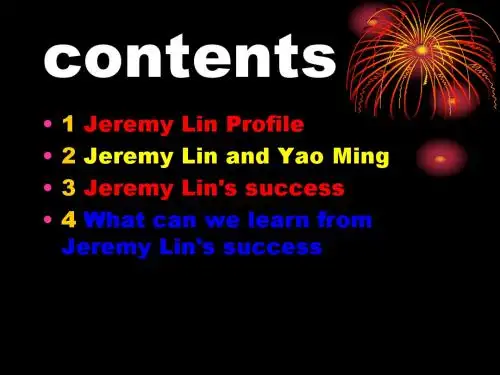
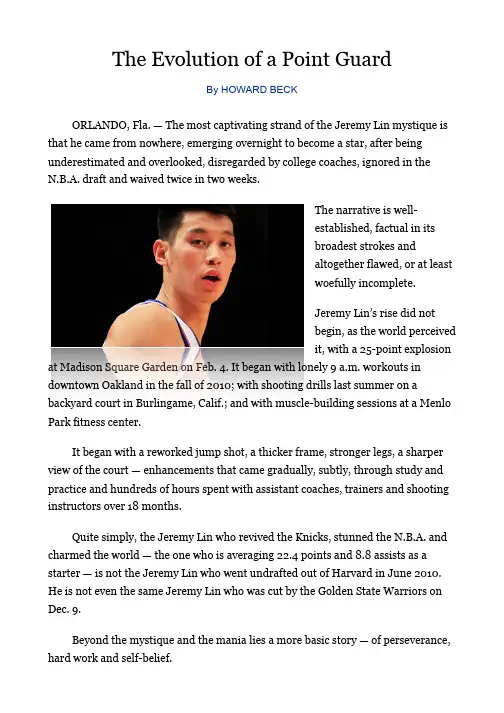
The Evolution of a Point GuardBy HOWARD BECKORLANDO, Fla. — The most captivating strand of the Jeremy Lin mystique is that he came from nowhere, emerging overnight to become a star, after being underestimated and overlooked, disregarded by college coaches, ignored in theN.B.A. draft and waived twice in two weeks.The narrative is well-established, factual in itsbroadest strokes andaltogether flawed, or at leastwoefully incomplete.Jeremy Lin’s rise did notbegin, as the world perceivedit, with a 25-point explosion at Madison Square Garden on Feb. 4. It began with lonely 9 a.m. workouts in downtown Oakland in the fall of 2010; with shooting drills last summer on a backyard court in Burlingame, Calif.; and with muscle-building sessions at a Menlo Park fitness center.It began with a reworked jump shot, a thicker frame, stronger legs, a sharper view of the court — enhancements that came gradually, subtly, through study and practice and hundreds of hours spent with assistant coaches, trainers and shooting instructors over 18 months.Quite simply, the Jeremy Lin who revived the Knicks, stunned the N.B.A. and charmed the world — the one who is averaging 22.4 points and 8.8 assists as a starter — is not the Jeremy Lin who went undrafted out of Harvard in June 2010. He is not even the same Jeremy Lin who was cut by the Golden State Warriors on Dec. 9.Beyond the mystique and the mania lies a more basic story — of perseverance, hard work and self-belief.“He’s in a miracle moment, where everything has come together,” said Keith Smart, the Sacramento Kings coach, who was Lin’s coach with the Warriors last season.Smart can hardly recognize his former pupil these days. Nor can Eric Musselman, who coached Lin in the N.B.A. Development League for 20 games. Nor can Lamar Reddicks, a former Harvard assistant coach, who fondly remembers a freshman-year Lin as “the weakest guy on the team.”“I look at him on TV now,” Reddicks said, “and I’m like, I can’t imagine that he’s this big!”What scouts saw in the spring of 2010 was a smart passer with a flawed jump shot and a thin frame, who might not have the strength and athleticism to defend, create his own shot or finish at the rim in the N.B.A. The evolution began from there.Eager LearnerLin earned a free-agent contract with the Warriors after a strong showing in the 2010 summer league, where he surprisingly outplayed John Wall, the No. 1 pick in the draft.Smart, then an assistant under Don Nelson, noticed something in Lin’s first pickup game against the Warriors’ young stars, Stephen Curry and Monta Ellis.“He’s getting to the paint,” Smart recalled. “You say, ‘Man, that’s a unique skill.’ Now he needs to pass the ball, as opposed to trying to get to the rim all the time.”Soon, Smart noticed something else. Lin was the first player at the Warriors’ training center every day, eating breakfast by 8:30 a.m. “Then, all of sudden, you’d hear a ball bouncing on the floor,” Smart said. Practice typically began at noon.Another assistant, Stephen Silas, began working daily with Lin, and provided him with a catalog of tapes showing elite point guards in the pick-and-roll: how they got into the lane, how they kept the defender on their hip, how they drew in theopposing big man to free up their pick-and-roll partner. Phoenix’s Steve Nash figured prominently. Silas and Lin worked on drills to give Lin other options, like a floater in the lane.Then Lin would get into a game and try to use what he had learned. But he would over-penetrate and miss the open man.“It wasn’t there yet,” Smart said.As for his perimeter game, Smartsaid, “Jeremy couldn’t shoot at all.”Lin had a habit then of pulling theball behind his head and tucking hisfeet up under him — “like he wasspringing up off a trampoline,” Smartsaid.Still, Lin kept arriving early,leaving late, devouring film andworking studiously with Silas and laterLloyd Pierce. But what Lin reallyneeded was game repetition. TheWarriors sent him to Reno, their D-League affiliate, on three occasions. That is where the lessons started to take hold.Stages of GrowthIn Lin’s first D-League tour, the focus was primarily on developing his pick-and-roll game.“He had no problems scoring for himself,” Musselman said. “It was more seeing the opposite side of the floor, and using the whole floor, instead of just the side the pick-and-roll was on. And he kept getting better and better at that.”Having yet to harness his aggression, Lin gotcalled for a lot of offensive fouls. Still, Musselmansaw something special immediately, a quality thatforetold possible greatness.“I thought he was one of the best dribble-driveguys I ever coached, up there with Gilbert Arenas,”Musselman said. “Things you can’t teach.”By Lin’s second tour, they were working on howto take a blow on the drive and still get off the shot.Musselman also introduced a middle pick-and-roll — one used frequently by Chris Paul in New Orleans — set just beyond halfcourt, in transition, to give the guard maximum room to drive.“That was the point when we knew that he was a special player,” Musselman said. “Because the more wide open the floor was, the better he became.”They also worked on how to read and attack defensive double-teams. On traps, Lin learned how to draw the opposing big man out and set him up before exploding past him.By Lin’s third D-League tour, he had also smoothed out his jumper and become more confident in his 3-point shot, which Musselman said was “probably the most dramatic change.”In 20 games, Lin averaged 18 points and 4.4 assists, while shooting .477 percent from the field and .389 from 3-point range. Throughout the experience, Lin urged Musselman to treat him like all of the other D-League players, and to push him just as hard.Musselman noticed something else, too. As an N.B.A. player on assignment, Lin got first-class plane tickets. “He gave them to teammates,” Musselman said.When Lin’s rookie season ended, the Warriors saw a player who might grow into a backup role behind Curry. They could not have foreseen the changes to come between July and December.Beating the GhostDoc Scheppler has coached in Bay Area high schools for 34 years. He first saw Lin as a scrawny eighth-grader. But even then, “he had the ability to see the floor, make the right decision, make the correct angle pass. And that is just not done at 13, 14 years old.”Last summer, Lin sought out Scheppler to help him with his 3-point shot. It was improving, but Lin was still shooting too high and throwing the ball — a “flying weapon,” Scheppler called it.Working mostly in Scheppler’s backyard in Burlingame, Lin learned to begin his shot on the way up and release it at his peak. They also worked on a variety ofin-game situations: the catch-and-shoot, off-the-dribble shots, and hesitation moves to create space.Lin’s perfectionist tendencies came out in a 3-point-shooting drill called “beat the ghost,” in which Lin earned 1 point for every shot he made at the arc and the “ghost” earned 3 points for every shot Lin missed.On one occasion, Lin made 17 3-pointers but lost 21-17, then kicked the ball in anger, Scheppler recalled with a chuckle. He refused to stop until he beat the ghost. It took 14 games. When Scheppler tallied up all of the scores for the day, Lin had converted 71 percent of his shots from the arc. “That’s the beauty of Jeremy Lin,” Scheppler said. “It’s not about moral victories. It’s ‘I have to win.’ ”Yet an outside shot would not be enough. Lin needed to be able to consistently convert shots in the lane. And to do that, he needed to withstand the contact.On Scheppler’s advice, Lin sought out Phil Wagner, a physician and trainer who owns Sparta Performance Science in Menlo Park. Wagner saw a player with enviable athleticism, but who lacked the explosiveness of an elite N.B.A. player.“Most basketball players can create force very quickly,” Wagner said, referring to a player jumping off the floor. “Jeremy couldn’t.”He compared Lin to a stretched-out rubber band — flexible, but lacking that snap-back quality. The goal was to make him “stiffer,” through a training program of heavy weights and low repetition, in conjunction with a high-protein diet. With the added muscle, Lin pushed his weight to 212 pounds from 200, while increasing his vertical leap by 3.5 inches, Wagner said. The result is evident every time Lin barrels into the lane this season.“The biggest thing I see is when he gets intro traffic, he’s able to maintain his direction and his balance, because he’s stronger,” Wagner said, adding, “He’s a physical guard. That’s where I see his hard work and the program he did with us paying off.”Wagner added: “Before, he was a motorcycle: he was maneuverable, but very off-balance. Now he’s like a Porsche: he’s fast, but he’s stable.”Unfortunately for the Warriors, they hardly had a chance to assess Lin’s off-season transformation. The N.B.A. lockout prevented them from working with him until camps opened in early December. He was on the court for maybe 90 minutes before the Warriors cut him in a move to clear payroll room to chase a free-agent center.Putting It All TogetherThe Knicks picked up Lin on Dec. 27, after training camps had ended, and after the Houston Rockets cut him, also for payroll reasons. The coaches were impressed with his solid 6-foot-3 frame and his athleticism. He instantly ranked among their top players in agility tests.But the coaching staff had seen little of Lin since the spring of 2010, when they put him through a predraft workout. Because of the compressed schedule, practices were few. Lin was fourth on the point-guard depth chart.Still, the same traits Lin showed in Golden State quickly emerged. He was the first to arrive every day, and the last to leave. He sought and devoured game tapes. When he requested his own clips, Lin asked to see his turnovers and missed jumpers, not his assists.In side sessions with the assistant Kenny Atkinson, Lin kept working on his jump shot and his decision making in pick-and-roll situations. The coaches instantly recognized his ability to blow past defenders, but without much regard for what he would do once he beat them. So they worked on footwork, judgment and subtle movements to freeze a defender.The work continued, quietly and without much notice, for five weeks, until Feb. 4, when 20 months of lessons coalesced into one eye-opening performance, and then a string of them.“He has a tremendous capacity for processing information,” Smart said. “When you talk to him, he’s looking you in the eye and he’s analyzing the information. He’s putting them in the folder in his mind. Now he’s opening the folder and pulling the things that he needs.”Now Lin is an entrenched starter for a quality team, with a jump shot that warrants respect and a passing touch on par with the league’s best. But the education continues. Teams are forcing Lin to go left, to his weaker hand. They are flustering him with multiple defenders. On Thursday, the Miami Heat held Lin to just 8 points and 3 assists, the worst performance of his otherwise-magical run.The box score shows failure. To Lin, it reads like a teachable moment.“I’m sure in the next couple weeks, someone’s going to figure out how to slow him down and stop him,” Reddicks said before the loss to the Heat. “It’s a chess match. He’s going to figure out how to beat that. That, to me, is a kind of a testament of who he is.”。
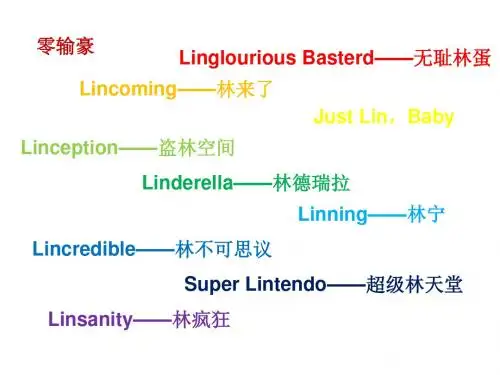

林书豪A Raising StarJeremy Lin, one of the most popular basketball players in NBA, plays for New York Knicksand leads his team to win, although he was fired by the Golden State Warriors and Houston Rockets. Jeremy Lin is a Chinese-American, who was born on August 23, 1988 in California, U.S.A.. He graduated from Harvard University, majoring in economics with a minor in sociology. During the school, he led Harvard University basketball team won the Ivy League group champion. After that, he signed with the Golden State Warriors and became the first Harvard University student to enter NBA since 1953 and the first Chinese –Americanplayer in NBA.林书豪,虽然曾被金州勇士队和休士顿火箭队开除,但他是NBA中最受欢迎的篮球运动员之一,他效力于纽约尼克斯队并领导他的球队取得胜利,林书豪是美籍华裔,出生于1988年8月23日,美国的加利福尼亚。
他毕业于哈佛大学,主修经济学,副修社会学。
在校期间,他领导哈佛大学篮球队赢得了常春藤联盟组冠军。
在那之后,他与金州勇士队签约,成为哈佛大学自1953年以来第一个进入NBA的学生,也是第一个在NBA的美籍华裔球员。
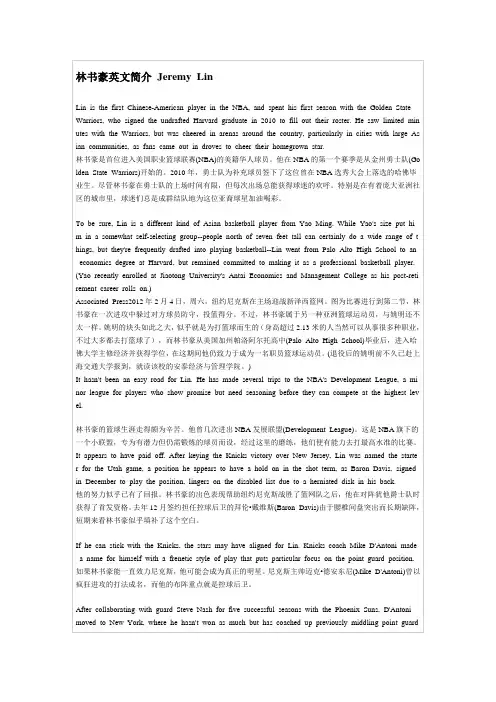
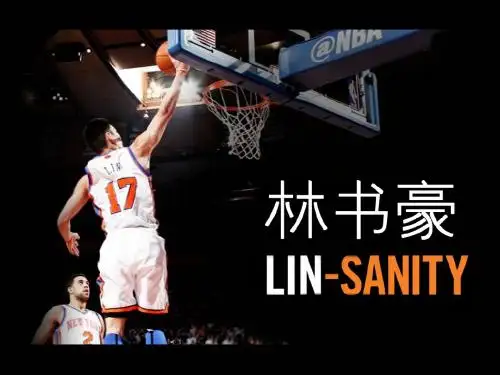
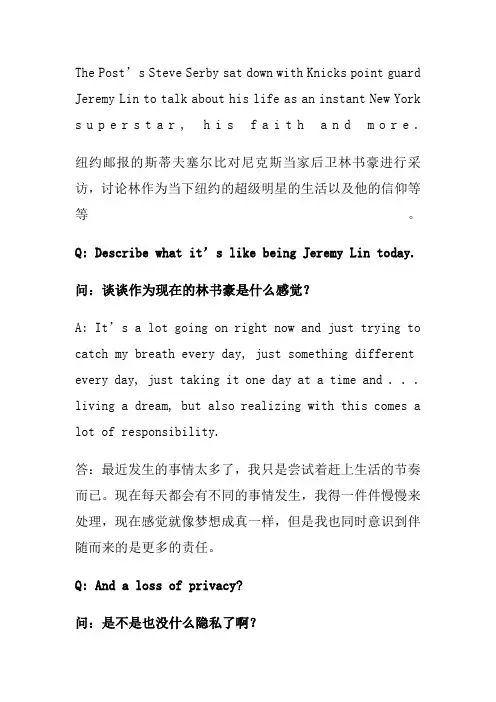
The Post’s Steve Serby sat down with Knicks point guard Jeremy Lin to talk about his life as an instant New York s u p e r s t a r,h i s f a i t h a n d m o r e. 纽约邮报的斯蒂夫塞尔比对尼克斯当家后卫林书豪进行采访,讨论林作为当下纽约的超级明星的生活以及他的信仰等等。
Q: Describe what it’s like being Jeremy Lin today.问:谈谈作为现在的林书豪是什么感觉?A: It’s a lot going on right now and just trying to catch my breath every day, just something different every day, just taking it one day at a time and . . . living a dream, but also realizing with this comes a lot of responsibility.答:最近发生的事情太多了,我只是尝试着赶上生活的节奏而已。
现在每天都会有不同的事情发生,我得一件件慢慢来处理,现在感觉就像梦想成真一样,但是我也同时意识到伴随而来的是更多的责任。
Q: And a loss of privacy?问:是不是也没什么隐私了啊?A: And a loss of privacy.答:对,也没啥隐私了。
Q: How do you feel about that?问:那你对此感觉怎么样?A: It’s obviously a little tough, just because I’m ki nd of more low key and private. But it’s a good opportunity, it’s a good platform.答:很明显会比较艰难一点,因为我比较注重低调和私人空间。
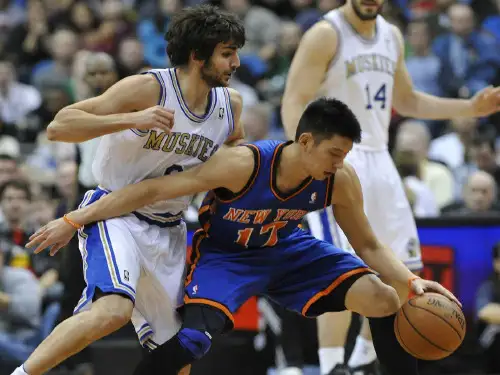
The Post’s Steve Serby sat down with Knicks point guard Jeremy Lin to talk about his life as an instant New York superstar, his faith and more.纽约邮报的斯蒂夫塞尔比对尼克斯当家后卫林书豪进行采访,讨论林作为当下纽约的超级明星的生活以及他的信仰等等。
Q: Describe what it’s like being Jeremy Lin today. A: It’s a lot going on right now and just trying to catch my breath every day, just something different every day, just taking it one day at a time and . . . living a dream, but also realizing with this comes a lot of responsibility.Q: And a loss of privacy?A: And a loss of privacy.Q: How do you feel about that?A: It’s obviously a little tough, just because I’m kind of more low key and private. But it’s a good opportunity, it’s a good platform.Q: Knicks fans are afraid to pinch themselves right now — do you not want to pinch yourself right now?A: Yeah, let’s keep this going (smiles).Q: Your 17 jersey is the No. 1 seller in the NBA, is that hard to believe?A: I mean, I think it’ll be like that for a little bit . . . and then things will resume to the way they were before (chuckles).Q: Why do you say that?A: Because right now, this is the thing that’s going on, and the Knicks are just a team that everyone’s watching, and so you’ll see a spike in jersey sales like when (Tim) Tebow first started, his jerseys went up, and then as the season went on, it kind of leveled out.Q: That’s a terrible thing when you lose your joy, isn’t it?A: Absolutely. I think now that I remind myself I’m playing for God. It frees me of all the other pressures that I was dealing with.Q: Would the best compliment for you be for someone tosay, “He makes his teammates better”?A: I think that would be the second-best compliment. The best would be, “When I see Jeremy play, I see him play for God and I see him bring joy on the court.”Q: What would people be surprised to learn about you? A: I love playing live video games . . . and I eat way more than anybody else.Q: Do you have a girlfriend?A: No.Q: Describe your ideal mate.A: First she would really love God and be a faithful Christian, and then after that, I think, a desire to serve other people, to help with the underprivileged, do a lot of social work . . . great personality and easy to be around. Someone that’s definitely chill, low key, low maintenance.Q: Are you more like your mother or father?A: My mom. We’re both stubborn and headstrong and we both have more of a vocal personality.Q: Scouting report on Jeremy Lin. How do you see yourself as a player?A: I think the scouting report is definitely don’t let me get to the basket, challenge my shots and . . . let me go left before you let me go right . . . try to be active and cause turnovers. I think that’s the scouting report I’d give against myself.Q: What do you think makes you unique as a point guard? A: I think play-making, being creative and . . . making different types of plays, and having a variety, I guess. Q: Do you get more pleasure distributing the ball than shooting it?A: I really like when a team. . . everyone’s hitting from all cylinders and there’s just nothi ng you can do to stop it. Because when you stop one, something else gives. That’s my favorite.Q: What do you hope Knicks fans are saying about you right now?A: I hope Knick fans are saying that it’s not about me (chuckles). I hope they’re understanding that it’s a lot about the team right now —the team vibe and theteam chemistry has a lot more to do than just one person can bring.Q: I’ve got bad news for you, they think it’s about you right now.A: Well they’ll see soon enough. I was trying to say the same thing at Harvard. And now they’re seeing how well Harvard’s doing even though I’m not there. It’s not always about one player, so we’ll see.Q: Did you ever think about giving up your dream? A: I mean at times I would say, “If this doesn’t work out, i f this year doesn’t work out, if this continues, I may have to draw the line somewhere.”Q: What was the worst instance when you were lost? A: I would probably just say when I was really, really arrogant, and ... I just didn’t listen to anybody, just my ty pical teenage years where it’s just rebelling.I think I know everything. I don’t need to hear anything from anybody, and I’m just going to do it my own way.Q: Who are the point guards you have liked watching over the years?A: Chris Paul, Steve Nash.Q: Because?A: Because you can’t measure their impact. You look at a team with them on the court, and then the team without them on the court..Q: Do you want to be a pastor?A: Somewhere down the road.Q: Why?A: I just think like when I’m done, I want to wa ke up every day knowing that I’m doing something that will have an eternal impact and eternal consequence.。